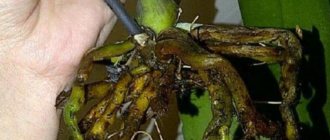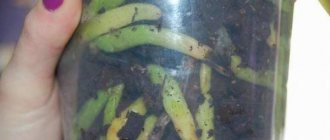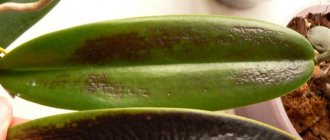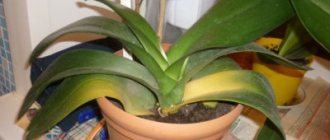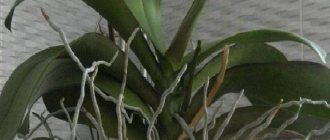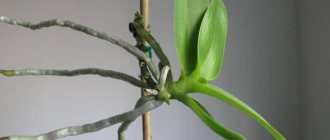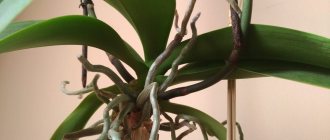One of the most popular types of orchids found in flower shops is Cymbidium. Now more than 100 species of various hybrids of this beautiful plant have already been bred. Cymbidium is not easy to care for at home, so when purchasing, beginners should familiarize themselves with the nuances of growing this orchid. But if you follow simple instructions, you will get a truly beautiful flower that will be the envy of all your neighbors!
Cymbidium does not have the usual bulb, but is limited to a pseudobud located on the stem near the ground. The pseudobulb is egg-shaped and looks like a compaction of the stem. This is where the moisture that nourishes the entire orchid is located. The leaves have a long, sharp shape, reminiscent of a sword.
The peduncle grows up to 1.5 meters in height. On the inflorescence itself there are flowers hanging loosely down; there can be either 10 or 2 of them. Cymbidium comes in different types, differing in both size and completely different colors: yellow, brownish, cream, reddish, pink, etc. Flower petals usually have the same shape for all species: lanceolate or crescent-shaped
Flowering in cymbidium lasts on average 1.5–3 months, and the period of its active development, when the plant pleases flower growers with its aesthetic properties, is 3–7 years.
Caring for Cymbidium
The conditions for seasonal maintenance of cymbidium are different and largely depend on temperature and air humidity. Low winter temperatures are very important for this type of orchid. Therefore, it is quite difficult to keep them in rooms with central heating. In private houses it is easier to find a place with suitable conditions.
| Season | Temperature | Humidity | Lighting |
| Spring | The preferred temperature during the day is 20–26ºС, at night from 13 to 15ºС. | Normal humidity is 60% and above. On the hottest days, it is necessary to spray the leaves 3 times daily. You should also take care of additional air humidification - a tray with wet filler, an indoor fountain, etc. | Bright diffused light, but not direct rays of the sun. East or west window, with shading during midday hours. |
| Summer | |||
| Autumn | Most cymbidiums prefer a cool room of 16–20ºС. Night temperature is 10–12ºС. | Should be placed away from central heating radiators. Increase air humidity by all available methods. | From October to March more light is needed. Therefore, place the plant on a south window. During the winter months, be sure to include additional lighting. |
| Winter |
Lighting
In general, cymbidiums tolerate direct sun and only hybrids based on Cymbidium devonianum (have wide leaves) acquire a yellowish tint.
South and west windows work well . The suitability of the eastern side must be tested experimentally.
If the growing of the plant lasts more than 9 months , then there is not enough sunlight and you need to use artificial light lamps or move it to a more illuminated place.
Good lighting is most important during the period of growing peduncles , buds and during flowering , since its fluctuations (sharp decrease) disrupt the supply of new cells with water, and the flowers fall off and the peduncles dry out.
What you need to know when choosing cymbidium
When going to a flower shop, you need to know how to choose a healthy plant, which in the future will only delight you with its beauty. Of course, you need to pay attention to the beauty of flowers. But that's not important. The main thing is to distinguish a healthy specimen from a sick one, and also take into account several aspects:
- An orchid is a child of the tropics, and if the outside temperature approaches 0ºC or drops below, this is not the best time to purchase a delicate flower. Even a short stay at such a low temperature can be detrimental to an orchid. Therefore, it is better not to take risks and postpone the purchase to a warmer time of year.
- Very often you can see in large supermarkets free-standing shelves with a wide variety of colors. Here they rarely receive proper care. And they get sick much more often than those sold in flower shops, greenhouses and greenhouses. That is why it is better to find specialized stores or centers in advance and go shopping where you can get not only a healthy flower, but also a full-fledged consultation with a specialist.
- Consider whether it is worth buying a plant that blooms profusely. Do not forget that it spends a lot of energy on the growth of flower stalks; flowering exhausts the orchid. And she still has to move into your apartment, adapt to the new atmosphere, temperature and humidity. All this may be beyond the capabilities of a profusely blooming orchid and it may get sick, even if you purchased an absolutely healthy plant. This does not mean that you need to buy a young plant that is not flowering. It's best to settle on the golden mean. Either the flower stalks have just begun to bloom, or there are only a few of them.
- Before purchasing an orchid, look carefully at how firmly it is planted in the pot. Very carefully, at the very base of the stem, move the plant slightly. If this happens, it means it was recently replanted and it has not yet had time to catch its roots on the soil. It is not advisable to purchase such a plant. Immediately look at the roots. Since the orchid is planted in transparent pots, this is not difficult to do. They should be elastic, not wrinkled or dry. Have a light green or white color if the flower sits in a dry substrate. If it has been recently watered, the color of the roots may be dark green. Neither gray nor brown should be present. Don't worry if your orchid's roots are hanging out of the pot. This is just normal. The main thing is that they are alive. The root system is the most important part, which not only supplies the plant with moisture, but also participates in the process of photosynthesis.
- Pay attention to the orchid leaves. If the leaves are dense, elastic, without damage and have the same shape, this is a good sign. If you notice any stains or scratches, then it is better not to take such plants, as the orchid will need a lot of strength to recover. Look at the growth points. They must not be damaged.
It is advisable to avoid purchasing orchids with damaged leaves.
How to grow roots on a Vanda orchid
If not cared for properly, Vanda loses its roots, and everyone needs to know how to build them up.
Often, if not properly cared for, the Vanda orchid loses some of its roots. In order to grow new roots, you need to remove the plant from the pot, rinse the root system with a fungicide solution at a temperature of about thirty degrees and dry. Then you need to remove all damaged roots and place the plant in a growth stimulator solution for ten minutes.
Taking a transparent pot, you need to fill it one-third with expanded clay and slightly moisten it. Wet sphagnum moss is laid on top of the drainage layer, in the center of which a depression is made, into which the prepared orchid is placed and covered with moss on top. The container with the plant is placed in a warm and well-ventilated room. The planting can only be moistened by spraying along the edge of the pot. Under favorable conditions, roots form a month after planting.
Reproduction
Cymbidium propagates in two ways - by dividing the bush and by seeds.
Dividing the bush
This is the easiest way to reproduce. It is combined with plant transplantation so as not to disturb the root system again.
- Remove the cymbidium from the pot.
- After cleaning, divide the plant into several parts, leaving on each divided plant several green bulbs and one brown, old one. It is in old bulbs that the cymbidium orchid retains useful substances, which it then uses in case of unfavorable conditions.
- Remove rotten and dry roots, sprinkle the cuts with charcoal and dry.
- Plant the cuttings in a suitable substrate. Spray, water moderately and keep in a warm place.
- The emerging young leaves will signal successful rooting.
How to germinate a seed?
You can try propagating the cymbidium orchid using seeds. Although it will take quite a lot of time.
- Orchid seeds are placed in pre-prepared soil consisting of crushed moss and leaf soil. The soil must be moist.
- Now it is very important to set a constant temperature between 22-25ºC and high humidity. These conditions can be obtained in small greenhouses.
- As soon as the shoots appear, we make a dive and continue to grow until 4 leaves appear.
- After which you can safely plant the seedlings in pots for permanent residence.
The process is complex, labor-intensive, lengthy, but interesting.
Cymbidium orchid is one of the most beautiful species of orchids existing on earth. Its maintenance requires special conditions, but it is quite possible to create them in any city apartment or country house. A little knowledge, proper care - and this queen of flowers will delight you with her magnificent flowers year after year.
Planting and transplanting
It is advisable to replant the cymbidium orchid every 3 years. Transplantation is done after flowering has ended. If the plant is healthy, bloomed well, and is properly cared for, then each green bulb produces 1–2 babies per season. The main point of reproduction is just good care. If it is there, then there will be no difficulties with division.
Cymbidium is replanted infrequently - once every 3 years
What soil to choose
The ideal soil for Cymbidium orchids is the bark of coniferous trees. Why conifers? Because this type of orchid loves acidic soil, and this is precisely what the crushed bark of coniferous trees provides.
If you decide to make the substrate yourself, then the ratio of the component parts is as follows:
- 3 parts pine bark,
- 2 parts sphagnum moss,
- 1 part sand
- 1 part perlite
- 1 part charcoal.
There is no urgent need to make this planting mixture yourself. Nowadays, any flower shops sell ready-made soils for orchids. Feel free to use them.
The pot should not be large in volume, otherwise the plant will “fatten”, growing a large leaf mass, but not bloom. The size of the planting pot should be slightly larger than the orchid's root system.
When is it time to replant?
How do you know if it’s time to transplant an orchid into a new pot or if it’s not time yet? Everything is very simple. Look at the center of the plant pot. If the greenery around the edges is very thick, and the roots fill the container so much that it is impossible to insert a pencil, then the time has come to replant the flower.
Step-by-step transplant
- Remove the cymbidium from the pot.
- As a rule, the roots of a transplanted plant grow strongly together. To unravel them, you need to lower the plant into a container of warm water.
- In the middle of the root system you can see dry roots that are gray in color or rotten ones that are soft and black. They need to be removed with a sharp knife. This must be done carefully and carefully so as not to damage the young root system.
- After removing everything dry and rotten, you need to leave the orchid for 10 minutes so that the wounds, sprinkled with activated carbon or cinnamon, dry.
- Pour drainage into a new pot, and lay fresh substrate on top, in a layer of at least 3 cm.
- Then you need to put the plant in a pot, carefully placing the roots among the substrate, which should be moistened by this moment.
- The cymbidium transplanted into a new container is placed in a dark place, here it will take root and recover from stress.
On the bark
There are other less common rooting methods. One of them is the bark method. For this you will need a fairly large piece of pine bark. If the bark was not purchased in a store, but was brought from the forest, it must be disinfected before use. To do this, place it in a container of water and boil for an hour. Once cooled, it can be used.
If the bark is purchased and is in a dry state, soak it in water for several days before using it. Rooting an orchid on dry ground will not work.
The process of rooting on the bark consists of the following stages:
- The pre-prepared orchid is carefully fixed on a piece of bark. In this case, its base must touch the surface.
- The root collar is treated with a solution of vitamin B 1.
- It is not necessary to spray or water the orchid during the rooting process. The moisture in the bark is enough for her.
On average, the process of root formation on the bark lasts about 3 months. During this time, the bark will have to be re-soaked. After the roots have developed, the plant can be immediately planted in its usual substrate.
So we found out how you can help an orchid grow roots. Of course, this does not always work out. To increase your chances of success, the most common mistakes made by novice gardeners are discussed below.
Secrets of care
The health of the orchid depends on proper care.
How to water correctly
This process has its own characteristics. They practice 2 types of watering - soldering and immersion.
- When using the immersion method, the pot with the plant is placed in a container filled with water. The pot should be in liquid almost to the very top. The entire procedure takes 40–45 minutes. During this time, the substrate is thoroughly impregnated with water.
- The second method is soldering. It differs from the first one in that the plant is placed in an empty container and watering is carried out from above. So we moisten until the water reaches almost to the top of the pot. The substrate is completely wetted very quickly, in 10–15 minutes. After such watering, the plant can not be disturbed for about 10 days.
How to find out about the need to water an orchid? Since this flower is usually planted in transparent pots, it is easy to determine the moment when the plant needs watering. As soon as the condensation on the inner walls of the pot disappears, the roots lose their greenish color, become light and silvery, this is a signal that it is time to water the plant.
It is very important to properly water the cymbidium orchid, since the health of the plant depends on this and whether it will please its owners with flowering. In summer and winter, the frequency of humidification is different. In winter, as a rule, there is little light and plant development slows down. Accordingly, watering is carried out less frequently.
When watering, it is very important to ensure that water does not get into the axils of the leaves covering the pseudobulb. If even a drop of moisture gets there, you need to remove it with a paper napkin, which will absorb the liquid, or simply tilt the plant and the water will drain.
Seasonal watering table
| Season | Water temperature | Number of waterings |
| Spring | 25º-27ºС | Once every 7–8 days |
| Summer | 25º-27ºС | Once every 7–8 days |
| Autumn | 25º-27ºС | Once every 10–12 days |
| Winter | 26º-30ºС | Once every 14–15 days |
Top dressing
Feeding an orchid is simple. Special fertilizers are sold in flower shops. It is preferable to use Ideal, Rainbow, Kemira Lux. These are proven and high-quality fertilizers. Fertilizer application should be combined with every 3rd watering. This applies to the spring period. In June and July, you need to reduce the application of nitrogen fertilizers. Examine an orchid and you will definitely see what the plant is missing. For example, if you notice yellowing leaves, then perhaps there is not enough potassium in the soil. If a plant grows slowly and appears to be in a stunted state, it most likely lacks nitrogen. When a leaf is weakly colored and loses its elasticity, this indicates a lack of magnesium.
The solution to these problems will be the use of fertilizers with a high content of the element missing by the plant.
When the first flower stalks appear on the cymbidium, stop feeding until flowering stops completely.
You can use a commercial orchid mixture as soil. If you prefer to prepare the substrate yourself, then take conifer bark, sphagnum, charcoal, vermiculite, coarse sand and leaf soil. Mix until the soil is loose. The drainage layer must be thick.
Fertilize with special fertilizers for orchids. Fertilizers are applied once every 2 weeks at half the recommended dose. In winter, you should choose fertilizers with a low nitrogen content.
Bloom
The duration of flowering varies among different varieties of cymbidium. But all varieties and types of this orchid have one thing in common - they will never bloom if the air temperature exceeds +22ºC.
How to make cymbidium bloom?
In order for the cymbidium to bloom, it is necessary to create suitable conditions for it, as close as possible to the mountainous areas that were its original habitat. What are these conditions?
- First of all, the difference between day and night temperatures is at least 4–5ºC. It is the difference that stimulates the formation of buds. If an orchid grows in a garden or greenhouse and its flowering occurs in spring and summer, then there is no need to specially adjust the temperature regime. But in winter, heating is turned on in houses and temperature fluctuations here are more difficult to achieve. If you have an insulated loggia, then you can place the plant there at night. Cymbidium orchid tolerates temperatures down to 5–6ºC without any problems. And in this case you will definitely achieve flowering.
- You also need bright light, but with shading from the direct rays of the sun.
The largest flowers appear on the plant in the 3rd year of life. At this time, up to 25–30 flowers can bloom on the cymbidium peduncle! And this spectacle can be enjoyed for more than 2 months.
As soon as the orchid stops blooming, know that the plant is preparing for a period of rest. To provide him with comfortable conditions while he rests, it is necessary to do pruning. If this is not done, then after some time the cymbidium will gather its strength and bloom again. But this greatly weakens the flower, it can get sick and even die.
What to do with the peduncle after flowering?
The orchid has faded, but the peduncle is still green. What should I do? Wait to see if it starts to dry on its own. And if this is exactly what happens, let the plant get all the nutrients from the peduncle and only then cut it off.
Has the flower stalk turned completely yellow? You can start removing it. The cut should be made so that a small stump remains at the base, about 1–1.5 cm.
How to care during the dormant period?
Some orchids do not need a rest period. But for cymbidium this period is a physiologically necessary condition. In nature, this time occurs during unfavorable weather conditions. Being able to freeze for a while helps the plant more easily tolerate cold temperatures, drought or scorching heat.
Cymbidium usually goes to rest at the end of October or beginning of November. At this time, a noticeable change occurs in the content of the plant. The frequency of watering is reduced to a minimum - once every 14-15 days, the air temperature drops to 10-12ºC. Such changes in the life of an orchid help flower buds to form and produce abundant blooms next season.
Basic mistakes
You will not need to work on mistakes and miscalculations if you follow the recommendations for growing roots and create optimal conditions for the orchid.
And yet, why don’t the roots grow:
- Be sure to treat the cuts with activated carbon. You can also use fungicides to avoid infections;
- Without proper lighting, it is difficult to grow roots at home. This is sometimes forgotten. Especially in winter;
- Do not remove leaves that are fading or beginning to turn yellow. They still have reserves of nutrients necessary for a weakened plant.
What to do if the leaves turn yellow, the base begins to rot and other care errors - table
A beginning florist has many questions, the answers to which do not always come on time. And the owner of a wonderful plant makes mistakes. If yesterday the orchid was healthy, and today you notice leaves turning yellow or starting to turn black, do not rush to panic. It is not necessarily a disease or some pest that is killing your plant. Most likely, these are symptoms of improper care. What mistakes do the owners of these flowers make? Let's look at some of them.
| Error | Cause | Elimination |
| Shriveled, yellowing leaves with pinpoint damage |
|
|
| Yellowing and rotting of pseudobulbs |
|
|
| Yellowing of leaves |
|
|
| Blackening of leaf tips |
|
|
| Curling leaves |
|
|
Chemical insecticides
How to treat an orchid with chemicals? Chemical-based drugs should be used:
- When biological agents have failed;
- Or the plant is severely damaged by pests.
When the orchids are neglected, they use chemicals.
For processing, you should choose a product with the lowest hazard class (3 or 4) of the new generation. It should be used strictly following the instructions and safety precautions. All means are:
- Absolutely safe for plants;
- Acting exclusively on pests.
The composition of insecticides is based on chemicals that are absorbed by the plant and transmitted to pests during feeding . Insects die within the first day. Repeated treatment should be carried out after 2 weeks until the pests completely disappear. To avoid addiction, it is recommended to alternate between different drugs.
Such drugs include :
- Aktara;
- Tanrek;
- Aktellik;
- Vertimek.
The convenience of such drugs lies in their speed of action and high efficiency . The solution is easily absorbed by the plant through the roots and leaves, without interfering with its proper development and growth.
Types of Cymbidium
Science today knows more than 100 varieties of cymbidium, which are cultivated by flower growers around the world. However, only a few dozen species have become widespread, and the most interesting of them will be briefly described below.
Eburneum (lat. Cymbidium eburneum)
. In common parlance, this variety is also called ivory for the beautiful creamy shade of its rather large flowers with wide petals. The smell of eburneum is strongly reminiscent of blooming lilacs. The plant loves a temperate climate, so it is actively grown in our latitudes.
Aloe leaf (in Latin: Cymbidium aloifolium).
This is a type of dwarf orchid that stretches upward to a height of no more than 0.3 m. From spring to autumn, the plant pleases the eye with small (4–4.5 cm in diameter) flowers with a delicate pale yellow, cream or burgundy tint.
Lanceolate (in Latin: Cymbidium lancifolium).
The flowers of this variety are quite small (no more than 5 cm in diameter), and their petals and sepals are colored light green, with a dark burgundy vein running through them. A beautiful contrast is created by a white lip, which has a thin green mesh and red splashes. The flowering period begins in April and lasts until October.
Day (in Latin: Cymbidium dayanum).
The orchid is distinguished by a dense inflorescence consisting of small (no more than 5 cm in diameter) flowers, the petals and sepals of which are shaded in a beautiful ivory shade, and a dark red vein runs through their center. In the wild, this species is found in Sumatra and the Philippines. At home, the plant blooms at the end of summer and pleases with its appearance until December inclusive. Two varieties have gained the greatest popularity in Europe: Tavoy and Twelf.
Tracy (Lat. Cymbidium tracyanum)
- This is a multi-flowered variety of orchid. Predominantly grown commercially for cutting, as its individual flowers grow up to 15cm in diameter and are a beautiful yellowish-green shade dotted with brownish-red veins. The delicate cream-colored lip has a wavy, and less often fringed, shape. The forming brush can reach 1.2 m in length, and it can simultaneously contain two dozen flowers that appear in the period September-January.
Low (in Latin: Cymbidium lowianum)
- another popular type of epiphyte with large flowers up to 20 cm in diameter. The petals and sepals are yellowish-green, and the 3-lobed lip is dark crimson. Low's orchid grows 0.8–1.2 meters in height, and its linear emerald leaves reach 0.75 m. In its natural environment, the plant is found in Burma, where it enters the flowering phase from February to June. Among our popular Lowe varieties, it is worth highlighting “Liliput”, which is more valued than others for its spectacular appearance.
Yellowish-white (in Latin: Cymbidium eburneum).
The homeland of this orchid is the Himalayas, where it reaches quite large sizes. Its flowers are 7.5–8 cm in diameter and are painted in a delicate cream shade. The lip has a wavy edge, a yellowish ridge and beautiful red splashes that create an impressive contrast.
Sword-leaved cymbidium (lat. Cymbidium ensifolium)
settles on the rocks of the Asian region. The inflorescence is formed from small flowers (3–4 cm in diameter) in the amount of 4–9 pieces and adorns an erect peduncle, which can have different lengths ranging from 15–65 cm. The flowering period extends from January to early May. The petals are painted in a pale yellow shade, which is successfully combined with dark red veins and inclusions located closer to the base. Among the most popular types of sword-leaved cymbidium are Peter Pan, Lovely Melody and Golden Elf.
Wonderful (in Latin: Cymbidium insigne).
A characteristic feature of this orchid are the petals, painted in a pale pink shade and showing a specific shape, red spots. The blade-shaped lips also have burgundy spots on their surface, and their wave-shaped edge bends slightly back. In one inflorescence there are up to 15 flowers, each of which is up to 8 centimeters in diameter, and they are formed in the period February-May. In the natural environment, the remarkable epiphyte species is found in Vietnam, Thailand and China.
Dwarf variety (in Latin: Cymbidium pumilum)
It is distinguished by petals that have a brownish-red tint and are bordered by a thin yellow stripe. The lip shows a white tint and dark red spots, and the central lobe is slightly curved and blunt-pointed. The inflorescence is erect, up to 12 cm in length, consisting of large flowers about 10 cm in diameter. Dwarf cymbidium is considered a very rare species, and it is grown mainly in China and Japan, although recently, due to its decorative properties, it is increasingly being bred in Europe and Russia. The flowering period of this orchid is December-March.
Giant cymbidium (lat. Cymbidium giganteum)
forms inflorescences of 15 flowers with a diameter of about 11 cm, which emit a pleasant aroma. The petals are green-yellowish in color and dotted with thin red veins, and the lip has a delicate cream color and is also covered with a network of thin red stripes. The inflorescence located on a powerful peduncle stretches up to 50–60 cm in length, which is why this species got its name. Natural habitat: Himalayas. The flowering period begins in November and lasts until mid-April. A characteristic feature of the giant cymbidium is that its flowers, after being cut, can last for a long time (up to 4 weeks) without losing their decorative properties. The most popular among amateur gardeners is one of the varieties called “Red Chile”, which is the name given to a compact indoor orchid with flowers of a rich red hue.
Varieties of cinnamon
Many people associate cinnamon with an aromatic spice. It's worth knowing that there are two popular types of cinnamon: one is the properly prepared bark of a tree called Ceylon (Cinnamonum verum), the other is from the aromatic cinnamon tree, also known as Chinese cassia (Cinnamonum cassia). Culinary Ceylon cinnamon is considered more valuable and healthy, but the basic properties of both varieties are similar. They are also sold simply as "cinnamon", especially in powdered form.
Pests and diseases of cymbidium
Deformation of parts of the plant, yellowed leaves and shriveled flowers (not blooming) signal the appearance of pests: aphids, spider mites, scale insects. If harmful insects are detected, they are removed manually, after which the plant is washed with a solution of laundry soap. If there are too many pests, you will have to resort to insecticides. Cymbidium is easily susceptible to viral diseases. Mosaic spots appear on the leaves. Unfortunately, in this case, the plant will have to be destroyed to prevent the spread of the virus. Cymbidium flowers are affected by gray rot, and leaves are affected by brown rot. Treatment consists of removing the infected parts, reducing watering and increasing the temperature.
| Pest diseases | Symptoms | Reason for appearance | Control measures and prevention |
| Black rot | The affected tissues turn black. The source of infection quickly spreads to healthy tissue. If the disease is neglected, the orchid may die. | Low temperature combined with high humidity of the substrate and air. |
|
| Cymbidium mosaic | Chlorotic spots and streaks appear on the leaves, which are located parallel to the central vein. Gradually they become more defined and darken. The orchid begins to lag behind in growth, the intensity of flowering decreases. | Improper care and pest damage weakens the plant. |
|
| Anthracnose | Clearly defined brown spots appear on the leaves, gradually growing and connecting with each other. | High temperature and humidity. |
|
| Shchitovka | Brown tubercles appear on the plant. The pest greatly slows down the growth of the orchid because it feeds on its juices. | Low air humidity. Temperature too high. |
|
| Aphid | These sucking parasites settle on the back side of the leaf. A plant affected by aphids is weakened and can be infected with viral diseases. |
|
Cymbidium does not bloom.
If your cymbidium is turning beautifully green, but is clearly not going to bloom, give it a shake-up: reduce watering and arrange a difference between day and night temperatures of 4-5 degrees. Night temperature 10-13 ºC is optimal for forcing cymbidium to flower.
Cymbidium is drying out.
If only the ends of the leaves dry, it means that the air humidity in the room is not high enough. You will have to spray the plant more often (remember: at least three times a day) and place the pot on a tray with wet pebbles. Sometimes the tips of the leaves dry out from too frequent or abundant moisture - the soil should dry out between waterings.
Cymbidium turns yellow.
Sometimes this is a sign that the roots are rotting. Try removing the top layer of substrate and examining the roots. If rot is detected, if it is not too late, the plant will have to be replanted, clearing the root system of rotten areas. And try to determine the cause of the decay, otherwise the situation may repeat itself.
Among the pests that are dangerous for orchids are spider mites, aphids and scale insects, and among the diseases - brown and gray rot, mosaic and sooty fungus. Mosaic is a viral disease that cannot be treated, so the plant will have to be destroyed, but you can fight rot: remove the affected parts of the plant, reduce watering and move it to a warmer room.
floristics.info/ru/stati/2129-orkhideya-tsimbidium-ukhod-v-domashnikh-usloviyakh.html
Reanimation of an orchid without roots
If you suddenly get your hands on an orchid with or without rotted roots, do not rush to throw away the plant, it can be saved.
- Cut off any rotten roots. Cut off the blackened areas completely, down to healthy green tissue. Pre-disinfect the knife or scissors you use - boil or wipe with alcohol. It is important that the growing point with leaves remains intact. If the rot has not yet reached it, then the plant can definitely be saved.
- Treat all sections with crushed activated carbon, rubbing it into the tissue of the damaged plant. Let the orchid come to its senses, leave it alone for a few days.
- During this time, try to purchase any foliar food for orchids, for example, Dr. Foley Orchid. And start spraying the preserved foliage of the plant with it. And spray the cut where the roots should appear with warm water with a few drops of succinic acid.
- Cymbidium without roots should be fixed in a container with damp moss or bark. Place in a warm place (temperature 25ºС).
- Don't expect quick results. It may take months for roots to appear. But we want to save the plant. Therefore, we must be patient.
There is another method that can be used to grow roots from a damaged plant. You need to hang the orchid with its leaves down in a closed container so that the place where the roots form is at the top. The vessel must be closed, in the form of a greenhouse. Spraying is carried out 2-3 times a week with warm water with the addition of root growth stimulants. With this method, water does not get into the axils of the leaves and does not cause rotting. The orchid is kept in this suspended position until roots appear.
Source - makgreen.ru
Biological drugs
So how to treat an orchid against insects? Biological insecticides can be used to control most pests .
Biological agents can be used to control pests.
The main advantage is their safety, since the components in the composition are of natural origin. They:
- Not dangerous to humans or animals;
- Do not accumulate in plants;
- Do not cause pests to become addicted to the components.
It is better to use them when the orchid infection is at an early stage . Such drugs may not cope with more complex cases. To completely eliminate insects, it is better to carry out repeated treatments.
The basis of such drugs are :
- Mushrooms;
- Bacteria;
- And entomogenic nematodes.
Treatment with drugs should be carried out only in the evening . The ambient temperature should be that specified in the instructions for the drug.
Fungal-based insecticides have a pronounced neurotoxic effect . After the drug penetrates the insect's blood, it causes paralysis and then its death. On sale you can find:
- Mycoafidin;
- Pecilomycin;
- Verticillin;
- Metarizin.
The most convenient preparations for use are based on bacteria . They are available in powder form. While mushroom-based drugs can cause allergic reactions in humans, allergies to bacteria-based drugs are rare. The most common are:
- Fitoverm;
- Bicol;
- Biotlin.
The most effective drug today is Nembact, based on entomopagenic nematodes. They penetrate inside the pest’s body and stop its development phases. Complete death of pests occurs after a maximum of 3 days.
Properties of cinnamon
- In many countries, cinnamon is used to flavor sweets and baked goods, as well as a wide range of recipes (meat, fish, mushrooms).
- The beneficial properties of cinnamon are due to its diverse chemical composition, rich in active substances. It contains, among other things, cinnamaldehyde, epicatechin, coumarin polyphenols, fatty acids and vitamins. Many compounds have a positive effect not only on humans, but also on plants.
- Cinnamon also has some medicinal properties, among other things, it acts as an antifungal, antibacterial, rot inhibitor, and also resists the development of mites and viruses. The diterpenes it contains are known to have insecticidal properties, which should be used when growing plants.
- Due to the high cost of the spice, it is more used for growing indoor and balcony flowers. In particular, cinnamon is recommended for treating species that are susceptible to pests, such as potted fuchsia or citrus crops. Plants can be sprayed with an aqueous solution of cinnamon or watered.
- Flower buds are vulnerable to many diseases and insect parasites. Sprinkling with cinnamon powder will increase the chance of abundant and harmonious flower development.
Cinnamon powder for children's sandbox
If ants have gotten into your garden sandbox, you can drive the insects away by simply mixing the sand with a few packets of cinnamon powder. Before doing this, it is advisable to check how the child reacts to the smell of the spice. You can also wipe the sandbox body with cinnamon essential oil.
Note: Cinnamon oil is quite strong and you need to be careful not to get the substance on your skin in its pure form. You can dilute it with regular warm water. Also, cinnamon oil has an intense odor, so after treating the sandbox, it is better for the child not to play there for several hours.
